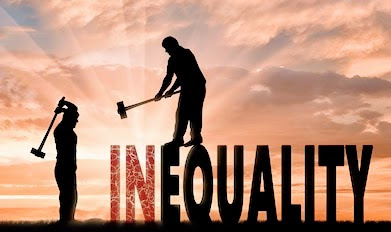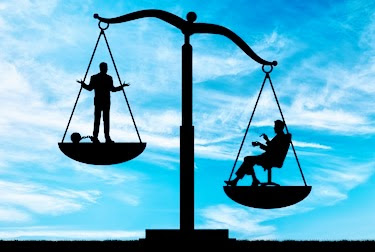Good morning friend,
Inequality - Poverty :- Leave alone measurement even the concept of poverty is complicated and to solve the main issue of poverty is inequality
Inequality - Poverty :- Concept definition and estimate of poverty the difficulty in defining precisely the poverty line the centre statistical organisation which has studied poverty recently concluded that study of inequality - poverty conducted by Bardhan Minhas Ojha Dandekar and Rath the estimate of poverty given by the the VII finance commission the latest definition and estimate given by VI plan document poverty line is defined as the midpoint of the monthly per capita expenditure class having daily calorie intake of 2400 per person in rural areas and 2100 in urban areas at 1984 - 85 prices the mid-point are Rupees 107 in rural area and rupees 122 in urban areas according to formal definition in 1977 - 78 the percentage of people below the poverty line 51% in rural area 38% in urban area and 48% .
All India wide variation in the incidence of poverty among different States 4% in Nagaland 15% in Punjab and 66% in Orissa the definition of poverty As given about take into to account only the minimum food requirement other requirements like clothing housing excetra and are taken into account for the people below the poverty line average monthly consumption expenditure workout to rupees 53 where as the average monthly consumption for an Indian is only rupees 96 this shows that many people above the poverty line are not having a satisfactory standard of living.
Link here :-
Indian Economy - To Improve Time, Money Problem.
Inequality In India
B) Removal of poverty during the plan period :-
Removal of poverty recognised as an important aspect of Social Justice one of the basic objective of planning in India although general rise in the standard of living in face in the formulation of the plans no concrete programs where launcher to deal with poverty during the first three plans only during the fourth plan Ad Hoc measure were taken to make a direct impact on poverty minimum needs programme was made an integral part of fifth plan with an allotment of rupees 2607 crore this program was rain force in the six plan.
C) VI Plan goods an anti poverty programmes :-
This VI plan deal with problem of poverty in three stages 1 identification and Measurement second development of Elastic targets third formulation of specific programs to match the target it is realised that the people below the poverty line generally have no assets are a little assets with very low productivity if you really want skill and no regular Jobs the target fixed by the 6 plan to reduce the percentage of people below the poverty line to 39% without any redistribution of consumption expenditure and to 30% with distribution of consumption expenditure through different anti poverty programmes the important anti poverty programmes of VI plan are IRDP , NREP special component plan for the treatment of the scheduled caste the integrated rural development programs is expected to covered 12 million household and to lift 61 million persons in rural areas about the poverty line nearly 6 million people in urban areas will also be brought about the poverty line NREP will supplement the Other anti poverty programs by providing jobs to the ruler poor during the slack season.
Link here :-
Culture - Use To Improve Sources Of Inspiration.
Poverty In India
D) Minimum needs programme :-
The program which was introduced in the plan has been continued in the plan with the following components elementary education including adult education ruler health ruler water supply ruler roads ruler electrification housing assistance to ruler handles people urban slum improvement and nutrition the program is conclude essentially as investment in human resource development provision of free or subsidised services through public Agencies is expected to improve the consumption level of the people below poverty line and thereby improve their productive efficiency it has been found that without a program like this the benefits of most schemes may fail to reach the poorest section of the people the allotment in the VI plan rupees 5907 crore long-term objectives and targets for 1984 - 85 have been fixed in the case of most of the times the state governments have to include that bulk of the expenditure except in the programs ruler water supply ruler health and elementary education which the centre will make substantial contribution.
E) Causes of feature to reduce poverty :-
a the main cause of poverty are under development and integrity in ruler areas poverty previous mainly among the agricultural labour and marginal farmer India won areas power 30 identified with people who are employed an unemployed and are migrant worker the impressive place on growth by the planets totally ignore the poverty of economic development no serious effort made to ensure that the benefits of the welfare scheme and economic assistance assistant reached mainly the lowest section of the people reduction in inequality was not considered indispensable for an attack on mass poverty production and distribution where generally treated separately the concomitant comment problems relating to land for reforms inflection technological innovation resulted in the worsening of the poverty situation.
Link here :-
Culture Of India - Religion, Secularism Language History Problems.
Inequality How To Solve
F) Equality in wealth and income :-
1. Bottom 20% of the population accounted for only 4% of the national income and the top five percent concurrent 31% during the poor household as one with asset less than rupees 2500 in 1971 the VI plan en-w many states that the percentage of such households has increased from 33 % in 1961 to 30% in 1971
2. World bank has classified inequalities into three categories: inequality prevails in the country where the share of the lowest 40% of the population in national income in less than 12% moderate inequalities in countries where the lowest 40% of population have a shared between 12% and 17% of the national income low equality prevails in countries where the lowest 40% of the population accounts for more than 70% of the national income India where the bottom 40% of the population account for 30% in 1967 - 68 comes in the category of moderate inequality countries.
G) Concentration of wealth in India :-
The Mahalabobis committee on the distribution of income in its reports of 1964 has analysed the problem of concentration of economic power in India the mono policy enquiry Commission headed by yes that also dealt with the concentration of economic power of in India the main cause of the concentration of wealth was the prevalence of managing system which was abolished theoretically through the first Constitutional Amendment another cause of concentration intercompany investment third cause maybe conquering of new opportunities and licence of industrial development by well established business houses absence of encouragement to new entrepreneurs according to Datt Committee report concentration of economic power has accelerated economic growth and has supplied managerial skill of high quality in India
The report has been criticized on various accounts based on its recommendation mono policies and restrictive trade practices act of 1970 was passed the Act defines a Big Business House as one with total asset of interconnected undertaking amounting 2 Rupees 20 crore or more in 1975 it was found that as many as 203 atoms were controlled by single farm monopolies the restriction on MRTP companies have recently been relax very much to facilitate their setting of of industries in backward districts and for export promotion.
Poverty Define
H) Growth of monopoly capital and big business houses in India :-
Monopoly capital in the capital investment in joint operation or by a big business houses to acquire a dominant share in the corporate private sector stocks of industrial capital factor contributing to growth of monopoly capital are there control over Financial Institutions even after the nationalisation of banks their diversification and technological innovation government policy encouraging big business through tax incentive on various ground the role of public sector Financial Institutions like LIC and Industrial Development Bank of India grabbing of Business and industrial opportunities by big businesses houses through money Manipulation a few business houses are able to to control big companies even when their investment is very low for example Mafatlal group company in which family shareholding is less than 1% of the total assets Tata who sharing holding in their companies less than 0.4 % etc. big business houses have grown phenomenally since independence they have been allowed to invest in the crore sector following the Recommendation of the committee Tatas and Birlas having almost equal assets rupees 1500 crore each account for nearly 40% of the total asset of the top 20 business houses.
I) Measures of check concentration of economic power :-
efforts taken by the government from time to time have had little impact on preventing growth of monopoly capital and concentration of economic power from of the measures are expansion of public sector government participation Indian large scale industries licensing system tightening of company administration encouragement of small and medium entrepreneurs use of taxation .
MRTP act imposition of ceiling of urban property through urban land ceiling and Regulation Act of 1976. Economic growth, social justice, self reliance and modernisation with inequality - poverty are the four primary objectives of planning in India.




